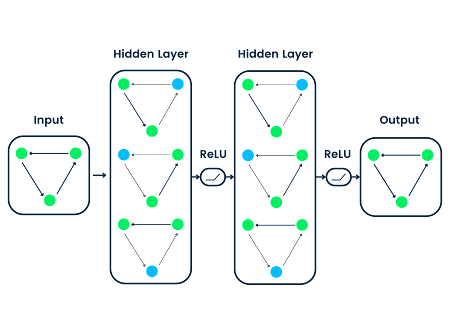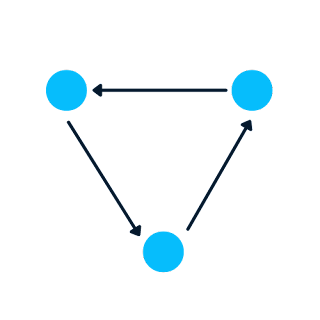Graph Neural Networks (GNNs) are a class of deep learning models designed to process and analyze graph-structured data. GNNs leverage the inherent structural information of graphs to learn powerful node and graph representations, enabling them to capture complex dependencies and propagate information effectively across the graph
Here, we will explore the capabilities of GNNs and their applications in various machine-learning tasks.
Capabilities of GNNs
GNNs offer several advantages in handling various machine learning tasks, including:
- Node Classification: GNNs can accurately classify nodes in a graph based on their features and the relationships they have with other nodes.
- Link Prediction: GNNs can predict missing or future links in a graph, enabling them to model dynamic relationships and make accurate predictions.
- Graph Classification: GNNs can classify entire graphs based on their structural properties and the features of their nodes and edges.
- Community Detection: GNNs can identify communities or clusters of nodes with similar characteristics, helping to uncover hidden patterns and structures in complex networks.
- Recommendation Systems: GNNs can provide personalized recommendations by analyzing the relationships between users, items, and their features in a graph.
- Natural Language Processing: GNNs can process and analyze text data represented as graphs, enabling them to capture semantic relationships and improve language understanding.
- Chemical Research: GNNs are used by chemists to research the graph structure of molecules or compounds, where nodes represent atoms and edges represent chemical bonds.
GNN Applications
The application of GNNs is not limited to the above domains and tasks. There have been attempts to apply GNNs to a variety of problems, including:
- Program Verification and Reasoning: GNNs can be used to analyze and reason about the behavior of computer programs, improving their reliability and security.
- Social Influence Prediction: GNNs can predict the influence of individuals in social networks, helping to identify key opinion leaders and target marketing campaigns.
- Electrical Health Records Modeling: GNNs can model and analyze large-scale electronic health records, enabling better patient care and disease prediction.
- Brain Networks: GNNs can analyze brain connectivity data, helping to understand the underlying mechanisms of brain function and neurological disorders.
- Adversarial Attack Prevention: GNNs can be used to detect and prevent adversarial attacks in various domains, such as computer vision and natural language processing.
Developing a GNN Model
The majority of GNNs are Graph Convolutional Networks (GCNs), which are shallow networks with three layers. To build a GCN model, we need to define the following components:
- Graph Structure: A graph consists of nodes and edges, representing entities and their relationships, respectively. We can use libraries like NetworkX or PyTorch Geometric to create and manipulate graph structures
- Node Features: Each node in the graph has associated features. These features can be represented as a feature matrix, where each row corresponds to a node and each column represents a feature dimension.
- Graph Convolutional Layer: The graph convolutional layer is the core component of a GCN. It performs message passing and aggregation operations to update the node representations based on their neighbors' information. We can implement this layer using the graph convolutional operation provided by the deep learning framework.
- Activation Function: After each graph convolutional layer, we apply a non-linear activation function, such as ReLU or sigmoid, to introduce non-linearity into the model.
- Output Layer: The output layer maps the node representations to the desired task, such as node classification or link prediction. For node classification, we can use a softmax layer to assign a probability distribution over the classes for each node.
Training a GNN Model
To train a GNN model, we need a labeled dataset, where each node is assigned a class label. The training process involves the following steps:
- Data Preparation: Split the dataset into training, validation, and test sets. Convert the graph and its associated features into the appropriate data structures supported by the deep learning framework.
- Forward Propagation: Perform forward propagation through the GNN model to obtain the predicted class probabilities for each node.
- Loss Calculation: Calculate the loss between the predicted class probabilities and the ground truth labels using a suitable loss function, such as cross-entropy loss.
- Backward Propagation: Update the model parameters by backpropagating the gradients of the loss function with respect to the model's parameters.
- Parameter Optimization: Use an optimization algorithm, such as stochastic gradient descent (SGD) or Adam, to update the model's parameters and minimize the loss function.
- Validation: Evaluate the model's performance on the validation set to monitor its progress during training and prevent overfitting.
- Testing: Once the model has converged, evaluate its performance on the test set to assess its generalization ability.
Testing a GNN Model
To test a trained GNN model, we can use the following steps:
- Data Preparation: Convert the test set into the appropriate data structures supported by the deep learning framework.
- Forward Propagation: Perform forward propagation through the trained GNN model to obtain the predicted class probabilities for each node in the test set.
- Evaluation: Compare the predicted class probabilities with the ground truth labels to evaluate the model's performance using suitable evaluation metrics, such as accuracy, precision, recall, or F1 score.
Example: Node Classification with PyTorch
Here's a code snippet that demonstrates how to develop, train, and test a GCN model for node classification using PyTorch and PyTorch Geometric:
import torch import torch.nn as nn import torch.nn.functional as F from torch_geometric.nn import GCNConv from torch_geometric.datasets import Planetoid # Load the Cora dataset dataset = Planetoid(root='/tmp/Cora', name='Cora') data = dataset[0] # Define the GCN model class GCN(nn.Module): def __init__(self, in_channels, hidden_channels, out_channels): super(GCN, self).__init__() self.conv1 = GCNConv(in_channels, hidden_channels) self.conv2 = GCNConv(hidden_channels, out_channels) def forward(self, x, edge_index): x = self.conv1(x, edge_index) x = F.relu(x) x = self.conv2(x, edge_index) return x # Initialize the model model = GCN(dataset.num_features, 16, dataset.num_classes) # Define the loss function and optimizer criterion = nn.CrossEntropyLoss() optimizer = torch.optim.Adam(model.parameters(), lr=0.01) # Training loop model.train() for epoch in range(200): optimizer.zero_grad() out = model(data.x, data.edge_index) loss = criterion(out[data.train_mask], data.y[data.train_mask]) loss.backward() optimizer.step() # Testing model.eval() _, pred = model(data.x, data.edge_index).max(dim=1) correct = int(pred[data.test_mask].eq(data.y[data.test_mask]).sum()) acc = correct / int(data.test_mask.sum()) print(f'Test Accuracy: {acc:.4f}')
In this example, we load the Cora dataset, which is a citation network with 2,708 nodes and 5,429 edges. We define a two-layer GCN model and train it for 200 epochs using the Cora dataset's training set. Finally, we evaluate the model's performance on the test set, achieving a test accuracy of approximately 81.5%.
Summary
In conclusion, GNNs are powerful tools for processing and analyzing graph-structured data. They offer unique capabilities in capturing complex dependencies and propagating information effectively across the graph. With their wide range of applications, GNNs are becoming increasingly important in various machine-learning tasks and domains.
In this article, we have explored the technical aspects of developing, training, and testing Graph Neural Networks (GNNs). GNNs are a powerful tool for processing and analyzing graph-structured data, with applications in various machine learning tasks. By understanding the underlying principles and implementing GNN models using deep learning frameworks like TensorFlow and PyTorch, we can leverage the power of GNNs to solve complex real-world problems.



Comments
Post a Comment